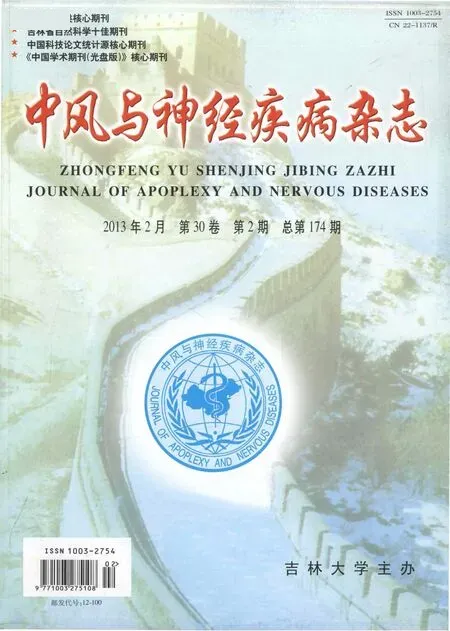应用圆分布结合候温法分析上海地区季节变化与急性缺血性卒中发病分布规律
王 岩, 祝 茗, 郭春妮, 王国栋, 王为珍
目前研究认为,气候变化是某些疾病的直接或间接诱发因素,尤其在心脑血管疾病方面。而对于气候变化与脑卒中发病关系,一直以来存在争议,不同国家、不同地区的研究结果存在较大差异[1~5]。本项研究通过对上海交通大学附属医院神经内科收治1587例诊断为急性缺血性卒中(acute ischemic stroke,AIS)患者资料进行分析,依据气象学“候温法”划分的四季为分类特点,观察AIS发病情况的分布特点。目的在于探讨上海地区AIS发病与季节变化的规律,为AIS的早期防治提供参考。
1 对象与方法
1.1 研究对象 2008年3月10日~2011年3月25日连续3年上海交通大学附属医院神经内科收治的AIS患者共1587例。诊断标准参照“2007年成人缺血性卒中早期治疗指南”[6],并经头部MRI或CT证实符合急性脑梗死影像特点。
1.2 研究方法 统一培训的神经内科专科医师将符合诊断标准病例逐一收集,包括性别、年龄、发病时间、既往病史、实验室检查及影像学资料,并输入数据库备用。气象资料来自于上海市气象局发布的同期气象资料。“候温法”划分四季的标准为:(1)出现连续五日日平均气温≥10℃,则为入春;(2)出现连续5d日平均气温≥22℃,则为入夏;(3)连续5d日平均气温<22℃,则为入秋;(4)连续5d日平均气温<10℃,则为入冬。脑梗死病因分型依据TOAST 分型[7]:(1)大动脉粥样硬化性(large-artery atherosclerosis,LAA);(2)心源性栓塞(cardioembolism,CE);(3)小动脉闭塞(small-artery occlusion,SAO);(4)其他原因(stroke of other determined cause,OC);(5)不明原因(stroke of undetermined cause,UND)。
1.3 统计分析 将调查和测量的资料输入数据库,核对后备用。计量资料以均数±标准差()表示,发病时间采用圆形分布法[8]统计分析,用雷氏检验(Rayleigh’s test)作平均角的假设检验与发病高峰日的估计[9~11]。采用 SPSS14.0 及 Microsoft Excel分析。
2 结果
2.1 一般情况 符合AIS诊断标准患者共计1587例。其中,男性 958例(60.37%),女性 627例(39.51%),平均年龄66.27 ±12.54 岁;高血压 795 例(50.10%),糖尿病337例 (21.20%),房颤 154(9.70%),冠心病131(8.30%),高脂血症143(9.00%)。依据TOAST分型标准,LAA 794 例(50.00%),SAO 419 例 (26.40%),CE 163 例(10.30%),OC 89 例(5.60%),UND 120 例(7.60%)。
2.2 逐月AIS发病情况圆形分布 分析显示:平均角正弦值Y=0.9832,平均角余弦值X=-0.18,平均角 αi=100.43°,角离差 S=155.27,角离散度 γ=0.05,雷氏值 Z=4.73 > Z0.05=2.99(P <0.05),平均角为100.43°,平均角 95%CI(αi± θ)82.28°~190.15°。高峰月依据平均角可信区间推算为3月24日~7月12日,高峰日依据平均角推算为4月12日。雷达图趋势分析显示,AIS发病集中趋势在2月~7月间,其中2、3月趋势最明显(见表1)。
2.3 不同亚型逐月AIS圆形分布 LAA、CE、OC、UND四型平均角假设检验P>0.05,平均角不存在;SAO型平均角正弦值Y=0.9993,平均角余弦值 X=-0.03,平均角 αi=88.05°,角离差 S=125.42,角离散度 γ =0.09,雷氏值 Z=3.48 >Z0.05=2.99,故 P < 0.05,平均角(αi)88.05°,平均角95%CI(αi± θ0.05)38.30°~ 137.75°。根据平均角可信区间估计发病高峰月为2月8日~5月19日,高峰日根据平均角推算为3月31日。雷达图趋势分析显示,各亚型发病高峰趋势几乎分布于2月~5月期间(见表2)。

表1 1587例急性缺血性卒中发病逐月圆分布分析

表2 1587例不同急性缺血性卒中亚型中圆分布分析
3 讨论
上海位于北纬31°11’,东经 121°29’,气候特点为冬夏长,春秋短,雨热同期,日照充分,夏季高温多雨,冬季温和少雨。依据柯本气候分类法[12]属于温暖带副热带湿润气候型。此类气候型主要分布于美国东南岸、中国东南部、日本南部、巴西南部、南非东南海岸及和澳大利亚东岸。虽然关于卒中与气候关系的研究涉及南北半球广泛区域的多个气候带[13~17]。但迄今为止,并未见温暖带副热带湿润气候型代表区域的气候与AIS发病关系的报道。
虽然对于时间序列数据,其他统计学方法均可进行分析,但是采用圆分布分析更为合理[8,9]。我们通过对2008年3月10日(气象意义入春)~2011年3月25日(气象意义冬末)3年1578例逐月AIS患者圆分布分析发现,AIS发病季节高峰较平缓(角集中度γ值偏小,角离散度S值偏大),但其仍存在一定集中趋势,发病高峰月为3月下旬至7月中旬,其中4月12日达到高峰。依据上海地区气象特点,此段时期正值春夏交替及夏季中期,气象特点为:冷暖气流交替频繁,温差变化较大,最低温度5~8℃,最高可达20℃以上,进入6月梅雨期后,相对湿度增大(75% ~100%)、气压偏低。
关于温度在卒中发病过程中的角色特别具有争议性。80 年代,Berginer[16]等证实,当环境温度高于月平均温度时,卒中发病风险显著提高。最近,Dawson[18]等的一项对1990年 ~2005年6389例急性脑卒中患者的回顾性分析发现,环境温度在先前温度基础上每升高1℃,AIS的发病率增加2.1%;然而,Feigin[19]等在对西伯利亚地区1929例AIS患者的研究发现,环境温度每降低2℃,AIS发病率增加1.32倍。随后,韩国及英国[20,21]学者相继在各自的研究中,得到了类似的结论;值的注意的是,最近的一项研究则认为:不论气候寒冷或者温暖,较大的温差变化(>5°C;OR:2.0;95%CI:0.7 ~5.9)才是增加AIS发病风险的主要因素[22]。上海地区春夏交替时期,温差较大,尤其是进入4月,昼夜温差普遍达到9℃ ~10℃左右。因此,温差变化可能是导致上海地区AIS发病高峰出现的原因之一。
大气压变化可能增加脑卒中发病风险的观点目前普遍已被认可,但多数学者的研究结论集中在气压变化与出血性卒中间的关系[23~25]。而针对 AIS的研究涉及甚少,仅 Jiminez-Conde J[26]等在其研究中证实气压变化与非腔隙型梗死发病率呈负相关(OR:2.41;P<0.001)。上海地区的气压变化特点为,冬高夏低,1月为全年最高,7月为全年最低。冬、夏季风控制期间变化小,春、秋过渡期间变化大。12~1月气压仅升0.3hPa,7~8月气压仅差1.5hPa;而3~4月和4~5月则骤降4.7~5hPa。这种气压的骤降可能是导致AIS发病高峰出现危险因素之一。另外,对于湿度是否增加AIS发病风险,目前的研究并未证实,亦未见相关报道。总之,结合上海地区发病高峰时期气候变化特点,温度变化、气压降低以及湿度增加均有可能是导致AIS发病高峰出现的原因。
目前,气候与脑卒中发病情况,文献资料所报道的结果不尽相同,多数学者的研究倾向于冬季AIS发病率高[15,27,28]。而 Turin[29]等研究认为春季 AIS发病率高。然而,目前所有已经发表的多项研究中,完全是按照整月划分四季。但在实际气象变化过程中,无论是哪个地区何种气候类型,四季的更替并不是完全按照整月变化的,尤其在季节交替过程中,温度、压力、湿度等气象因素反复多变。因此,完全按照整月来划分四季,不能完全真实反映AIS在季节变化中的特点。我们的研究依据“候温法”对四季进行气象意义的划分,能够更加准确的反映四季更替情况。结果显示,上海地区不同季节AIS日均发病总体差异不明显,发病高峰月与高峰日在冬春交替以及夏中期(梅雨季节前后)出现,这与既往文献报道有一定区别。
对于缺血性卒中的研究,科学合理的病因分型后再进行分析,已成为普遍共识。但就目前已发表的气候与AIS的相关研究中,并未对各卒中亚型季节变化特点作进一步阐述。我们依据TOAST分型方法,对AIS患者进行病因分型,并分析各亚型与季节变化的特点。结果显示:仅有SAO型有较明显的集中趋势,存在平均角,季节高峰较平缓,发病高峰月2月初至5月中旬,其中高峰日为3月31日左右。此期恰为上海地区冬末春初时期,也正是冷暖气流交替频繁时段。这提示我们对于不同亚型AIS的防治,各季节应有所侧重,尤其是对于上海地区冬末春初时期SAO型卒中较高发病趋势,需引起足够重视。
综上,本研究提供了一种将圆分布分析与候温法相结合的全新的分析气候变化与AIS发病关系的方法。通过以上研究,不仅提示我们上海地区的AIS防治,既要注重各季节的均衡性,又要警惕春初以及夏中时期发病高峰。而且为其他疾病与气候变化的研究提供一种新的思路。
[1]Biller J,Jones MP,Bruno A,et al.Seasonal variation of stroke-does it exist[J].Neuroepidemiology,1988,7(2):89-98.
[2]Oberg AL,Ferguson JA,McIntyre LM,et al.Incidence of stroke and season of the year:evidence of an association[J].Am J Epidemiol,2000,152(6):558-564.
[3]Dawson J,Quinn T,Walters MR.Under the weather with stroks,more data emerge[J].Int J Stroke,2009,4(1):19-20.
[4]Giua A,Abbas MA,Murgia N,et al.Climate and stroke:a controversial association [J].Int J Biometeorol,2010,54(1):1-3.
[5]McArthur K,Dawson J,Walters M.What is it with the weather and stroke[J].Expert Rev Neurother,2010,10(2):243-249.
[6]Adams HP,del Zoppo G,Alberts MJ,et al.Guidelines for the early management of adults with ischemic stroke:a guideline from the American Heart Association/American Stroke Association Stroke Council,Clinical Cardiology Council,Cardiovascular Radiology and Intervention Council,and the Atherosclerotic Peripheral Vascular Disease and Quality of Care Outcomes in Research Interdisciplinary Working Groups:the American Academy of Neurology affirms the value of this guideline as an educational tool for neurologists[J].Stroke,2007,38(5):1655-1711.
[7]Adams HP,Bendixen BH,Kappelle LJ,et al.Classification of subtype of acute ischemic stroke.Definitions for use in a multicenter clinical trial.TOAST.Trial of org 10172 in acute stroke treatment[J].Stroke,1993,24(1):35-41.
[8]Li GN,Hoffman-Kim D.Evaluation of neurite out growth anisotropy using a novel application of circular analysis[J].J Neurosci Methods,2008,174(2):202-214.
[9]Zar JH.Biostatistical analysis[M].4th ed.Upper Saddle River,NJPrentice Hall,1999.20-28.
[10]Bjorksten KS,Bjerregaard P,Kripke DF.Suicides in the midnight sun-a study of seasonality in suicides in West Greenland [J].Psychiatry Res,2005,133(2 ~3):205-213.
[11]Bjorksten KS,Kripke DF,Bjerregaard P.Accentuation of suicides but not homicides with rising latitudes of Greenland in the sunny months[J].BMC Psychiatry,2009,9:20.
[12]Peel MC,Finlayson BL,McMahon TA.Updated world map of the Kappen-Geiger climate classification [J].Hydrol Earth Syst Sci,2007,11(5):1633-1644.
[13]Giroud M,Beuriat P,Vion P,et al.Stroke in a French prospective population study[J].Neuroepidemiology,1989,8(2):97-104.
[14]Shinkawa A,Ueda K,Hasuo Y,et al.Seasonal variation in stroke incidence in Hisayama Japan[J].Stroke,1990,21(9):1262-1267.
[15]Wang Y,Levi CR,Attia JR,et al.Seasonal variation in stroke in the Hunter Region,Australia:a 5-year hospital-based study,1995-2000[J].Stroke,2003,34(5):1144-1150.
[16]Berginer VM,Goldsmith J,Batz U,et al.Clustering of strokes in association with meteorologic factors in the Negev Desert of Israel:1981-1983[J].Stroke,1989,20(1):65-69.
[17]Chang CL,Shipley M,Marmot M,et al.Lower ambient temperature was associated with an increased risk of hospitalization for stroke and acute myocardial infarction in young women[J].J Clin Epidemiol,2004,57(7):749-757.
[18]Dawson J,Weir C,Wright F,et al.Associations between meteorological variables and acute stroke hospital admissions in the west of Scotland[J].Acta Neurol Scand,2008,117(2):85-89.
[19]Feigin VL,Nikitin YP,Bots ML,et al.A population-based study of the associations of stroke occurrence with weather parameters in Siberia,Russia(1982-92)[J].Eur J Neurol,2000,7(2):171-178.
[20]Hong YC,Rha JH,Lee JT,et al.Ischemic stroke associated with decrease in temperature[J].Epidemiology,2003,14(4):473-478.
[21]Myint PK,Vowler SL,Woodhouse PR,et al.Winter excess in hospital admissions,in-patient mortality and length of acute hospital stay in stroke:a hospital database study over six seasonal years in Norfolk,UK [J].Neuroepidemiology,2007,28(2):79-85.
[22]Kyobutungi C,Grau A,Stieglbauer G,et al.Absolute temperature,temperature changes and stroke risk:a case-crossover study[J].Eur J Epidemiol,2005,20(8):693-698.
[23]Buxton N,Liu C,Dasic D,et al.Relationship of aneurysmal subarachnoid hemorrhage to changes in atmospheric pressure:results of a prospective study[J].J Neurosurg,2001,95(3):391-392.
[24]Lejeune JP,Vinchon M,Amouyel P,et al.Association of occurrence of aneurysmal bleeding with meteorologic variations in the north of France[J].Stroke,1994,25(2):338-341.
[25]Jehle D,Moscati R,Frye J,et al.The incidence of spontaneous subarachnoid hemorrhage with change in barometric pressure[J].Am J Emerg Med,1994,12(1):90-91.
[26]Jimenez-Conde J,Ois A,Gomis M,et al.Weather as a trigger of stroke.Daily meteorological factors and incidence of stroke subtypes[J].Cerebrovasc Dis,2008,26(4):348-354.
[27]Ricci S,Celani MG,Vitali R,et al.Diurnal and seasonal variations in the occurrence of stroke:a community-based study[J].Neuroepidemiology,1992,11(2):59-64.
[28]Anderson N,Feigin V,Bennett D,et al.Diurnal,weekly,and seasonal variations in stroke occurrence in a population-based study in Auckland,New Zealand[J].N Z Med J,2004,117(1202):U1078.
[29]Turin TC,Kita Y,Murakami Y,et al.Higher stroke incidence in the spring season regardless of conventional risk factors:Takashima Stroke Registry,Japan,1988-2001[J].Stroke,2008,39(3):745-752.

